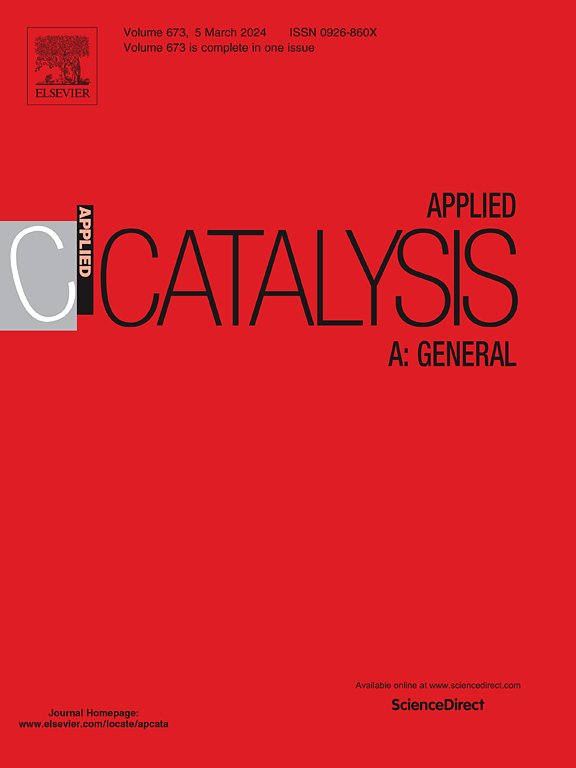Boosting catalytic activity of Ag-modified CeO2-Al2O3 mixed metal oxide support via coupling with a VUV photoreactor: A catalytic ozonation system applied towards VOC oxidation
IF 4.7
2区 化学
Q2 CHEMISTRY, PHYSICAL
引用次数: 0
Abstract
This study introduces a new air purification strategy that combines a vacuum ultraviolet (VUV) photoreactor as an in-situ source of O3 generation coupled with a fixed-bed ozonation reactor equipped with Ag-based catalysts. The results showed that the integration of the VUV photoreactor to the fixed-bed reactor significantly enhanced not only the conversion of acetone but also improved the O3 decomposition compared to the catalytic ozonation system alone in that the acetone and O3 conversion were boosted from 82 % and 86 %, respectively, to 100 % each. While the inhibitory impact of relative humidity (RH) on Ag/CeO2−Al2O3 activity using a fixed bed reactor was detected, coupling with the VUV photoreactor led to maintaining 100 % conversion of acetone and ozone even in the humid condition. Indeed, although RH poisoned the interface of the gas-catalyst, leading to an inhibition role in the catalytic reactions, it improved the VUV photolysis performance in the gaseous state, resulting in the enhancement of the coupled reactor’s performance compared to the only catalytic ozonation fixed bed reactor. Additionally, the in-situ regeneration capability, which was introduced to the air treatment system by combining the VUV photoreactor with the traditional catalytic ozonation, granted prolonged reusability of the catalyst with minimal activity reduction (less than 2 %). The attained data showed that the presence of binary metal oxide supports with an optimized 1:1 ratio had a key role in maintaining not only a complete conversion of acetone and ozone but also achieving above 99 % reaction selectivity towards complete oxidation. Finally, a mechanistic study was conducted where the in-situ diffuse reflectance infrared Fourier transform (DRIFT) analysis proved the role of surface carboxylate and electron paramagnetic resonance (EPR) data demonstrated the co-participation of .OH/.O2− radicals in acetone removal.
通过耦合VUV光反应器提高ag修饰CeO2-Al2O3混合金属氧化物载体的催化活性:一种用于VOC氧化的催化臭氧化系统
本研究介绍了一种新的空气净化策略,该策略将真空紫外(VUV)光反应器作为原位生成O3的源与配备银基催化剂的固定床臭氧化反应器相结合。结果表明,与单独的催化臭氧化系统相比,VUV光反应器与固定床反应器的集成不仅显著提高了丙酮的转化率,而且改善了O3的分解,丙酮和O3的转化率分别从82 %和86 %提高到100 %。在固定床反应器中检测了相对湿度(RH)对Ag/CeO2−Al2O3活性的抑制作用,与VUV光反应器的耦合使得即使在潮湿条件下丙酮和臭氧的转化率也保持在100% %。确实,RH虽然毒害了气体-催化剂的界面,导致了催化反应的抑制作用,但它提高了气体状态下的VUV光解性能,导致耦合反应器的性能比单一的催化臭氧化固定床反应器有所提高。此外,通过将VUV光反应器与传统的催化臭氧化相结合,将原位再生能力引入空气处理系统,使催化剂的活性降低(小于2 %),从而延长了催化剂的可重复使用时间。得到的数据表明,优化1:1比例的二元金属氧化物载体的存在,不仅对保持丙酮和臭氧的完全转化,而且对完全氧化的反应选择性达到99% %以上,具有关键作用。最后,进行了机理研究,其中原位漫反射红外傅里叶变换(DRIFT)分析证明了表面羧酸盐的作用,电子顺磁共振(EPR)数据证明了。oh /的共同参与。丙酮去除中的O2−自由基。
本文章由计算机程序翻译,如有差异,请以英文原文为准。
求助全文
约1分钟内获得全文
求助全文
来源期刊

Applied Catalysis A: General
化学-环境科学
CiteScore
9.00
自引率
5.50%
发文量
415
审稿时长
24 days
期刊介绍:
Applied Catalysis A: General publishes original papers on all aspects of catalysis of basic and practical interest to chemical scientists in both industrial and academic fields, with an emphasis onnew understanding of catalysts and catalytic reactions, new catalytic materials, new techniques, and new processes, especially those that have potential practical implications.
Papers that report results of a thorough study or optimization of systems or processes that are well understood, widely studied, or minor variations of known ones are discouraged. Authors should include statements in a separate section "Justification for Publication" of how the manuscript fits the scope of the journal in the cover letter to the editors. Submissions without such justification will be rejected without review.
 求助内容:
求助内容: 应助结果提醒方式:
应助结果提醒方式:


